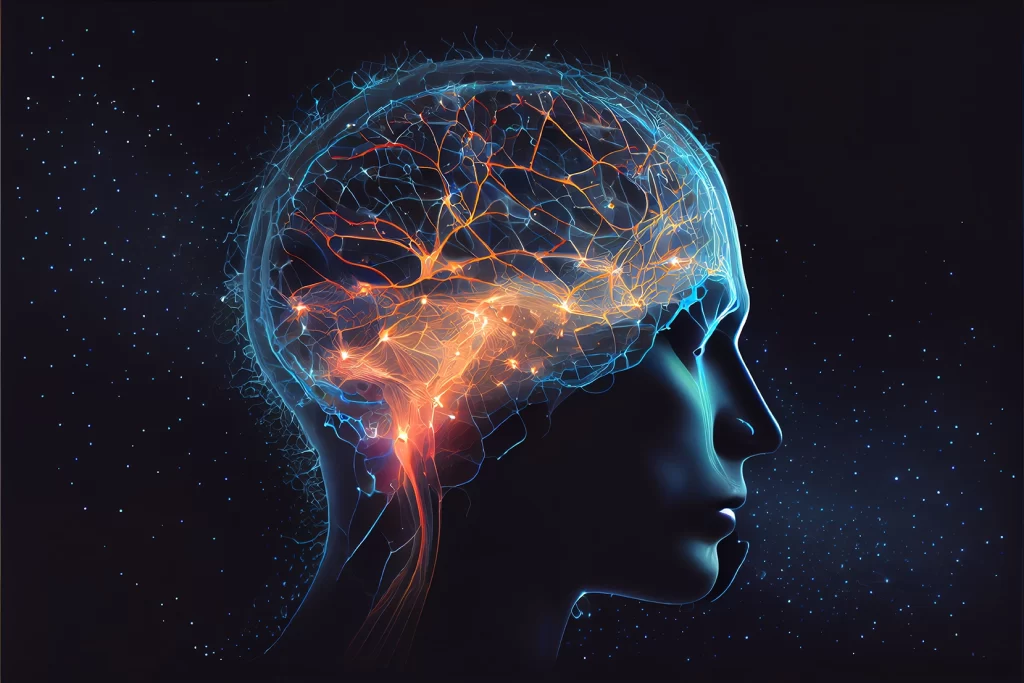Neuroplasticity, a term that once echoed only within the walls of neuroscience labs, has now become a buzzword in the realms of self-help, education, and wellness. But what is it, and why is it causing such a stir?
The definition of neuroplasticity
‘Neuroplasticity’ (a portmanteau of ‘neuron’ and ‘plasticity’) refers to the brain’s ability to reconfigure itself, forging new neural pathways and connections throughout our lives.
Historically, the prevailing belief in neuroscience was that the brain’s structure was largely immutable after a certain point in childhood.
This perspective was based on observations that certain functions, like language or motor skills, seemed to be “hard-wired” into specific regions of the brain.
If these areas were damaged, the function was often irreparably lost, leading to the conclusion that the adult brain was a static, unchangeable entity.
However, as the annals of scientific research expanded, so did our understanding of the brain. The 20th century brought groundbreaking studies that began to challenge these entrenched beliefs. Observations of patients who had undergone rehabilitation after strokes showed that they could regain functions, suggesting that other parts of the brain had adapted to take over the roles of the damaged areas. This was a clear indication of the brain’s adaptability — its neuroplasticity — even in adulthood.
The advent of advanced imaging techniques like functional magnetic resonance imaging (fMRI) provided more direct evidence of neuroplasticity.
Researchers could now visualize the brain’s activity in real-time and observe how it changed in response to various stimuli or injuries.
Today, we understand that the brain is not a static organ cemented in its ways after childhood. Rather, it’s a dynamic entity, continually reshaping itself in response to our experiences, behaviors, and environment.
Whether it’s learning a new language, recovering from a traumatic injury, or adapting to a novel environment, our brain demonstrates its resilience and adaptability every single day.
Neuroplasticity is, simply put, the brain’s lifelong journey of evolution, adaptation, and growth, and a reminder of its incredible potential and the mysteries it still holds.

Blog Contents
- How does neuroplasticity work?
- Hebbian and homeostatic plasticity
- How experience and learning impacts neuroplasticity
- Why neuroplasticity is key for rehabilitation and recovery
- How to increase neuroplasticity through improved lifestyle
- Better nutrition for stronger neuroplasticity
- Exercises for neuroplasticity
- Exercising neuroplasticity through cognitive activities and puzzles
- Meditation for neuroplasticity
- Stress management for neuroplasticity
- How our environment affects neuroplasticity
- Better sleep for improved neuroplasticity
- Negative neuroplasticity
How does neuroplasticity work?
Neuroplasticity is possible thanks to the synaptic plasticity of our brains. Synapses — the junctions where neurons communicate — can strengthen (potentiate) or weaken (depress) based on the activity they experience. This dynamic nature of synapses is crucial for learning and memory.
The Hebbian theory, named after the psychologist Donald Hebb, elegantly captures this idea with the phrase: “Neurons that fire together, wire together.”
When two neurons frequently activate together, the synapse between them strengthens. Conversely, if they rarely activate together, the connection weakens. This adaptive mechanism ensures that our brain refines its neural circuits based on experience.
Hebbian and homeostatic plasticity
While the Hebbian theory of neuroplasticity emphasizes strengthening connections through repeated activity, the brain also needs to maintain a balance. Enter: homeostatic plasticity.
Homeostatic plasticity ensures that the brain doesn’t go into overdrive with hyperactivity or become too inhibited. By adjusting synaptic strength in response to prolonged activity changes, the brain maintains a stable and optimal level of activity.
Think of it as the brain’s thermostat, ensuring things don’t get too hot or too cold.
How experience and learning impacts neuroplasticity
Every new skill we acquire, every emotion we feel, and every environment we explore changes our neural pathways and synapses, and evolves our experience-dependent plasticity.
For instance, musicians often have a more developed auditory cortex, a testament to the brain’s ability to reshape itself based on experience.
However, as we age, the rate and manner in which our brain exhibits plasticity changes. While certain aspects of plasticity decline, it’s not the end of the road. Targeted interventions like cognitive training or even simple activities like puzzles can still tap into the brain’s ‘plastic’ reserves, offering hope for cognitive enhancement in the golden years.
Why neuroplasticity is key for rehabilitation and recovery
Perhaps one of the most awe-inspiring demonstrations of neuroplasticity is functional plasticity.
When a part of the brain becomes damaged, say, due to a stroke or injury, all hope is not lost.
Other regions can step in, taking over the functions of the damaged area.
This remarkable adaptability makes rehabilitation therapies for brain injuries or neurological disorders a possibility.
How to increase neuroplasticity through improved lifestyle
Our daily choices and habits have a profound effect on the intricate web of neurons and synapses which make up our brains. Here are some of the lifestyle factors which shape how our minds function:
Better nutrition for stronger neuroplasticity
Omega-3 fatty acids, abundant in flax seeds, chia seeds, hemp seeds, and walnuts, are essential fats which are as good for the brain as they are for the heart. Our own study, ‘A Systematic Review of Omega-3 Consumption and Neuroprotective Cognitive Outcomes’, shows that Omega-3s — even those consumed via supplements — play a crucial role in enhancing synaptic plasticity, thereby improving learning and memory. They also help to maintain the integrity of the brain’s cell membranes, ensuring efficient signal transmission between neurons.
Strawberries and chia seeds are incredible for brain health. One of our favorite ways to consume both is in our Strawberry Rosa Chia Pudding.
Strawberries and chia seeds are incredible for brain health. One of our favorite ways to consume both is in our Strawberry Rosa Chia Pudding.
Antioxidants, found in blueberries, dark chocolate, and green tea, are also fantastic for neuroplasticity. They help combat oxidative stress, a major culprit behind neuronal damage. By neutralizing free radicals, antioxidants help in preserving neuronal structure and promoting plasticity.
A powerful brain-healthy breakfast that only takes a few minutes to make. Oat pancakes with a delicious homemade blueberry sauce.
A powerful brain-healthy breakfast that only takes a few minutes to make. Oat pancakes with a delicious homemade blueberry sauce.
Exercises for neuroplasticity
Beyond building muscle and cardiovascular health, physical activity is vital for the brain. Engaging in regular exercise, be it brisk walking, cycling, or yoga, stimulates the release of neurotrophic factors: chemicals which support the growth and survival of neurons.
One of the most-studied is the brain-derived neurotrophic factor (BDNF), which boosts neurogenesis, especially in the hippocampus, a region of the brain pivotal for memory and learning. So, the next time you lace up those sneakers, remember: you’re jogging for your neurons too!
Exercising neuroplasticity through cognitive activities and puzzles
Our brain thrives on challenges. Activities that make us think, reason, and learn are like a workout for our gray matter. Be it solving puzzles, reading a thought-provoking book, or picking up a new language, such mentally-stimulating activities bolster neuroplasticity. They enhance cognitive reserves and build a protective buffer against age-related cognitive decline. A curious mind is a resilient brain.
Meditation for neuroplasticity
The ancient practice of meditation, once the preserve of monks and spiritual seekers, is now gaining ground in neuroscience. Regular meditation has been linked to increased cortical thickness, improved attention, and even positive neuroplastic changes. It’s a testament to the adage that peace of mind leads to a healthier brain.

Stress management for neuroplasticity
While short-term stress can be a motivator, chronic stress is a neural nemesis. Prolonged exposure to stress hormones like cortisol can induce negative plasticity, impairing learning and memory. Managing stress through relaxation techniques, hobbies, or social connections is paramount for a ‘plastic’ and healthy brain.
How our environment affects neuroplasticity
Exposing the brain to a stimulating environment filled with novel experiences and challenges can significantly enhance its plasticity. Whether it’s through travel (which can be transformative for the brain), art, or even social interactions, enriching our environment can lead to profound positive changes in the brain.
Better sleep for improved neuroplasticity
Often overlooked, sleep plays a crucial role in neuroplasticity. It’s during deep sleep that the brain consolidates memories, strengthens synaptic connections, and undergoes synaptic pruning to eliminate unnecessary connections. Ensuring a good night’s sleep is vital for optimal brain function and plasticity.
Negative neuroplasticity
While neuroplasticity often brings to mind positive adaptations, it’s essential to understand that not all plastic changes are beneficial. For instance, chronic pain or phantom limb sensations post-amputation are examples of negative plasticity. This is why targeted interventions and therapies to guide plasticity in a positive direction are so essential.
The cognitive phenomenon of neuroplasticity is evidence of the brain’s incredible adaptability and resilience.
By understanding the mechanisms of neuroplasticity and making informed lifestyle choices, we can harness the brain’s potential, ensuring cognitive vitality throughout our lives.
Whether it’s through diet, exercise, mental stimulation, or stress management, every choice we make can shape the trajectory of our brain’s health and function.
In the ever-evolving landscape of neuroscience, neuroplasticity stands as a beacon of hope, reminding us of the limitless potential that lies within our minds.
References
Doidge, N. (2007). The Brain That Changes Itself. Penguin Books.
Kandel, E. R., Schwartz, J. H., & Jessell, T. M. (2000). Principles of Neural Science. McGraw-Hill.
Hebb, D. O. (1949). The Organization of Behavior. Wiley & Sons.
Turrigiano, G. G. (2008). The self-tuning neuron: synaptic scaling of excitatory synapses. Cell, 135(3), 422-435.
Draganski, B., & May, A. (2008). Training-induced structural changes in the adult human brain. Behavioural brain research, 192(1), 137-142.
Park, D. C., & Reuter-Lorenz, P. (2009). The adaptive brain: aging and neurocognitive scaffolding. Annual review of psychology, 60, 173-196.
Nudo, R. J. (2006). Plasticity. NeuroRx, 3(4), 420-427.
Gómez-Pinilla, F. (2008). Brain foods: the effects of nutrients on brain function. Nature Reviews Neuroscience, 9(7), 568-578.
Spencer, J. P. (2009). Flavonoids and brain health: multiple effects underpinned by common mechanisms. Genes & nutrition, 4(4), 243-250.
van Praag, H. (2008). Neurogenesis and exercise: past and future directions. Neuromolecular medicine, 10(2), 128-140.
Hertzog, C., Kramer, A. F., Wilson, R. S., & Lindenberger, U. (2009). Enrichment effects on adult cognitive development: Can the functional capacity of older adults be preserved and enhanced?. Psychological science in the public interest, 9(1), 1-65.
Lazar, S. W., et al. (2005). Meditation experience is associated with increased cortical thickness. Neuroreport, 16(17), 1893.
McEwen, B. S. (2007). Physiology and neurobiology of stress and adaptation: central role of the brain. Physiological reviews, 87(3), 873-904.
Diamond, M. C., Krech, D., & Rosenzweig, M. R. (1964). The effects of an enriched environment on the histology of the rat cerebral cortex. Journal of Comparative Neurology, 123(1), 111-120.
Nudo, R. J., Wise, B. M., SiFuentes, F., & Milliken, G. W. (1996). Neural substrates for the effects of rehabilitative training on motor recovery after ischemic infarct. Science, 272(5269), 1791-1794.
Hebb, D. O. (1949). The Organization of Behavior. Wiley & Sons.
Turrigiano, G. G. (2008). The self-tuning neuron: synaptic scaling of excitatory synapses. Cell, 135(3), 422-435
Münte, T. F., Altenmüller, E., & Jäncke, L. (2002). The musician’s brain as a model of neuroplasticity. Nature Reviews Neuroscience, 3(6), 473-478.
Park, D. C., & Reuter-Lorenz, P. (2009). The adaptive brain: aging and neurocognitive scaffolding. Annual review of psychology, 60, 173-196.
Nudo, R. J. (2006). Plasticity. NeuroRx, 3(4), 420-427.

About The Author
Dean Sherzai, MD, PhD
Dr. Dean Sherzai is co-director of the Alzheimer’s Prevention Program at Loma Linda University. Dean trained in Neurology at Georgetown University School of Medicine, and completed fellowships in neurodegenerative diseases and dementia at the National Institutes of Health and UC San Diego. He also holds a PhD in Healthcare Leadership with a focus on community health from Andrews University.
Get more brain science direct to your email inbox
Sign up for the Brain Docs newsletter for weekly recipes, brain teasers, neuroscience facts, podcast updates, and more — for free!







